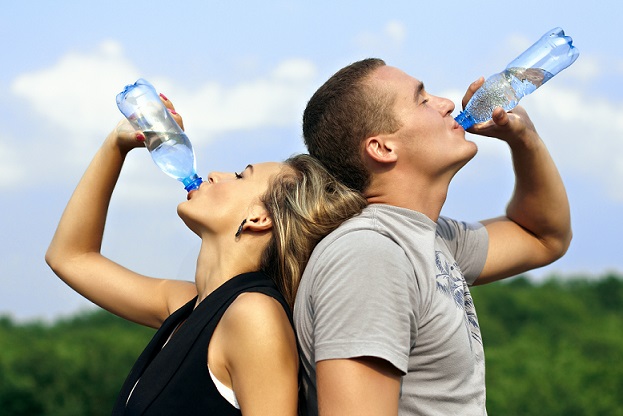
by Mark Pollard, MD
Whether it’s a round of tennis, mowing the lawn or lounging on the beach, the summer months are a popular time for people to be outside enjoying the longer days and warmer temperatures. However, as the thermostat rises, so do some of the hazards brought on by the arrival of hot weather.
Heat in the summer can affect people in different ways. Dehydration, for example, can easily occur if fluid loss from sweating is not properly monitored and restored. Some common signs of dehydration are fatigue, loss of appetite, flushed skin, light-headedness, dark-colored urine and dry cough. To prevent dehydration, don’t wait until you are thirsty to drink. Instead, drink water before and during an activity. It is recommended that you drink eight to sixteen ounces of water, or an electrolyte drink, for every thirty minutes of activity. Also, try to avoid caffeinated and alcoholic beverages when outside because they can exacerbate dehydration.
Dehydration can leave a person more susceptible to other heat-related illness, too, such as heat exhaustion. Heat exhaustion can occur suddenly when a combination of the heat, perspiration and inadequate fluid intake decreases the body’s ability to cool itself. A person may feel nauseous, weak and cold and could have a headache and fast heartbeat. He or she could also faint or vomit. To help remedy heat exhaustion, get into a cool and shady place, drink very cold fluids, jump into cool water and/or spray cold water on your skin. Also, when dressing for activities in the heat, use common sense. Wear a hat and light-colored, loose-fitting clothing made of breathable fabric to help keep cool.
If your body temperature exceeds 106 degrees, you may be at risk for one of the most dangerous warm-weather-related illness, heat stroke. Symptoms of heat stroke include hot, dry and red skin as well as a fast heartbeat, confusion and loss of consciousness. It can be life-threatening if left unchecked and is a good reminder that it is not only necessary to pay attention to the temperature but the humidity as well. The National Oceanic and Atmospheric Administration Heat Index divides risk categories into caution, extreme caution, danger and extreme danger based on the risk of heat-related illness. When the heat index is greater than 104 degrees, which falls into the danger or extreme danger category, it is best to avoid outdoor activities.
In addition to the heat, the sun’s rays can also cause problems. When the body is exposed to UV light, it protects itself by producing melanin, the dark pigment that gives skin its color. When the body produces excess melanin it darkens or tans the skin. However, when the skin is exposed to too much of the sun’s UV rays, it will cause the skin to burn. In severe cases, a person may experience pain, blisters, headaches and fever.
Sunburn can also increase a person’s risk for skin cancer in the future. The best treatment for sunburn is to prevent it from happening by applying sunscreen before and during sun exposure, wearing a hat and covering exposed skin.
The summer is a season of fun and great weather, but it can also present some dangers. Some common sense and awareness can go a long way to keeping you healthy all summer long.
Dr. Mark Pollard is an Orthopaedic Surgeon at Cooper Bone & Joint Institute and Assistant Professor of Orthopaedic Surgery at Cooper Medical School Rowan University. Learn more about Dr. Pollard here.
To make an appointment with Dr. Pollard or any of our orthopaedic specialists, please call 1.800.8.COOPER or fill out our online appointment request form.

Very helpful article and thanks for sharing.
Thanks for sharing. This article is very informative.